The Need for Compost
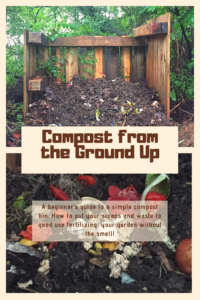 Growing up we had a compost bin out at the edge of the woods. I never paid it much attention. My father would fill it with whatever he got out of the chicken coop when it was cleaned out and I remember him putting lime on it once or twice. Outside of that it was just four posts wrapped with wire that we walked past on our way out to the “Big ditch” in the woods where we built forts.
Growing up we had a compost bin out at the edge of the woods. I never paid it much attention. My father would fill it with whatever he got out of the chicken coop when it was cleaned out and I remember him putting lime on it once or twice. Outside of that it was just four posts wrapped with wire that we walked past on our way out to the “Big ditch” in the woods where we built forts.
It was the key, I was told, to why our tomatoes were so big. I was not impressed. However, when we started our first garden, I ended up spending more than I wanted to on dirt. I spent some time trying to rack my brain about what we did so that I could get some free dirt to mix in with our nice Carolina clay next year when we plant again. How hard can it be? All dead organic stuff becomes dirt, right? You make a pile of it, wait, and next year you put it in your garden…or so I thought.
Starting the Wrong Way
Out of the kitchen…
As I made breakfast one morning I decided that I was starting the compost that day. As I cooked I had remembered we put our egg shells in the compost bin growing up. I added them to a bowl instead of throwing them out. When we eat eggs for breakfast, we use at least a dozen. Then I remembered a friend told me that they put used coffee grounds in their compost. We have five kids at home so coffee is the daily drug of life. I took the used coffee grounds out of the pot and dumped them and the filter on top of the egg shells. I moved the bowl of eggs and coffee grounds to the side counter and headed off to work.
That evening I was informed by my wife that my pile of trash needed to find its way outside or to the trashcan and that I should not leave piles of compost on the counter before leaving the house. Unfortunately I did not have a compost bin. Undeterred, I took everything outside to a pile of leaves near the back of our property. I dug a small hole in the leaves, dumped everything in it, covered it up and stood back feeling a deep sense of accomplishment for starting my compost.
…and into the Bin
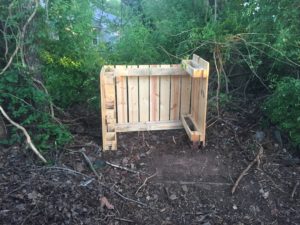 In the coming weeks I did make a basic bin out of skids I brought home from work. Depending on where you live, this may not be possible. My sister bought a kitchen bin. You can also just buy an outside bin if you don’t have time to make one.
In the coming weeks I did make a basic bin out of skids I brought home from work. Depending on where you live, this may not be possible. My sister bought a kitchen bin. You can also just buy an outside bin if you don’t have time to make one.
I moved the now growing pile of compost and leaves into the bin. I also added all table scraps including a few chicken carcasses and old broth to the pile. We then cleaned out the fridge so everything that had gone bad was added as well.
It was then that I began to be aware that while I was right about the fact that all this would become dirt, I was woefully ignorant about another fact: that process can vary greatly in both time and smell. As a coworker told me when I said I had started my compost bin: “There is a right way, and a wrong way.” I was now looking at a large pile of the wrong way.
Controlling Smell
Right Ingredients
The smell was the first thing on my list to deal with. I talked with a few people and apparently everyone but me knew that adding animal byproducts such as bones or dairy products is a no no even if they had only walked past a garden when they were six. Smell is not the only thing it causes; it also acts like a magnet to any small critters that live nearby. Definitely not the way to score points with new neighbors. While some things like egg shells appear on some people’s don’t compost list, meat, bones, and dairy products appear on every list I have seen.
Of course, practically everything can be composted if you have the space and time, but as I am living in more of the suburbs I thought skipping them was a good idea. Those that I have seen that compost everything generally have no close neighbors, are not concerned with rats, and are part of a community compost where there are larger quantities of material being added to the compost system than a typical single house compost bin. If any of those are issues for you, keeping meat and dairy to a minimum or avoiding them all together is highly advisable.
Right Air
Compost needs to breathe. Well, many of the organisms that break down the compost for you need to breathe. If there is not enough air in the compost, those that need it die and those that don’t suddenly have a surplus of food. The down side is the ones that don’t need the air produce methane and other not so pleasant smelling byproducts as they work. Bring back the air, and once again the organisms that need it start to thrive and starve out the others. While most of those organisms are microscopic, many are not. I got help from mealworms and soldier flies as the summer progressed. The first image is a mealworm, the second is of a soldier fly larva. Both can help speed your compost along.
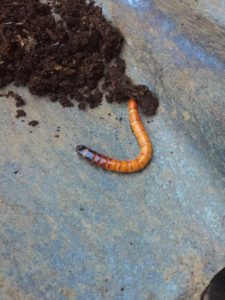
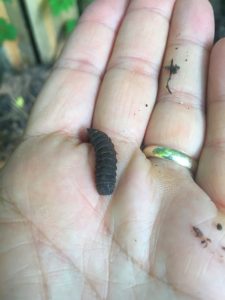
I started turning my compost every day. It helped a lot. If I had done it right from the start, once a week or less may have been just fine. Straw also helped. We had some straw left here by the previous owners. I used some of it to cover the compost after mixing it each day and then that got turned into the compost bin the next day. It still does not smell wonderful, but you have to stand over it and bend down to smell it now. I can live with that.
Controlling Speed
When everything is working perfectly, I have been told compost can be completed in a few weeks. Most people I have talked with can get it done in a few months. If I stopped adding fresh kitchen and yard scraps to my compost heap I could probably add it to a bed in a few weeks at this point. There is a lot of good black dirt with food scraps and yard waste mixed through it. It took a little while to get started as compost needs a critical mass to really get going. After I got enough volume in my pile, things took off on their own.
Too Much Green
I did however hit a bump in the road when everything seemed to slow to a stop and the temperature of the compost pile dropped to slightly above air temperature. I had been faithfully adding kitchen scraps, and turning the pile, but somehow it stopped working. The temperature fell and the rapid progress I had been experiencing ended abruptly.
What I didn’t know at the time was that compost needs both green and brown waste. Green waste, like fresh grass clippings and kitchen scraps are high in nitrogen which micro-organisms use for the production of proteins and other cell building molecules. Too much, and the PH of the soil changes and its hard for those organisms to survive, which was my problem. I had been adding a lot of kitchen scraps and nothing else.
Adding some Brown
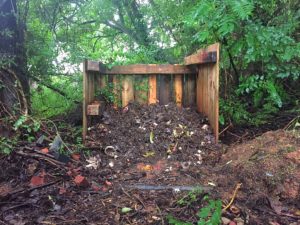 Brown waste, which is rich in carbon, include paper, dry leaves, straw, or wood chips. Carbon provides the energy source for the organisms to work. Once I added more leaves into my compost bin, it came back to life and the temperature spiked again. By mid summer I had used all the leaves I could find in my yard, so I started adding in paper waste.
Brown waste, which is rich in carbon, include paper, dry leaves, straw, or wood chips. Carbon provides the energy source for the organisms to work. Once I added more leaves into my compost bin, it came back to life and the temperature spiked again. By mid summer I had used all the leaves I could find in my yard, so I started adding in paper waste.
After a brief struggle with it, I found it fairly easy to keep a good balance. It did not need to be exact, I just needed to be aware that the compost needed both green and brown material and make sure that I was not adding only one over and over again without feeding it some of the other.
Simple Compost
In short, the organisms in compost need air, water and food. Turning your compost once a week keeps enough air in the mix for the right organisms to thrive. Rain can provide enough moisture, but you may need to water your compost if you live in a dry area, or cover it for a time if you get a lot of rain. It should be moist, but not soggy. Finally, a balanced diet for compost is composed of a good mix of nitrogen rich material and carbon rich material. Provide the basics, and nature will take care of the rest.
Next Steps
We have not had enough waste to have more than one bin this first year, we are going to start a second one this fall. The plan is to add half our leaves and other yard waste to the first bin and half to the new one. Through the winter we are going to add only to the second bin so the first has time to finish composting for the Spring. I have a book on being self sufficient on half an acre that advises to have a three bin system. I will be working toward that, but for now, I will probably be needing to use everything I manage to make for next Spring’s garden.
Two quick discoveries I learned from friends:
If you need free material for your compost to help get you started, Starbucks (and possibly other coffee companies) keep their coffee grounds for others to take for compost. Every Starbucks has a bucket and if you call ahead they will bag them up for you. Coffee grounds are a great “green” nitrogen rich material. Getting a few bags from a local coffee shop can help you get the critical mass you need to retain heat, as well as help in retaining moisture.
Starting a garden this year, I did not have a any compost at hand. I begrudgingly paid for dirt at local stores. It was later that I was told a lot of city dumps compost the yard waste they pick up. This is potentially a great way to get some very inexpensive compost. Of course, different dumps have different procedures, but it is definitely worth looking into. A dump truck full of compost at our city dump costs $20.00. If you need inexpensive compost in larger quantities, you can’t beat that.
